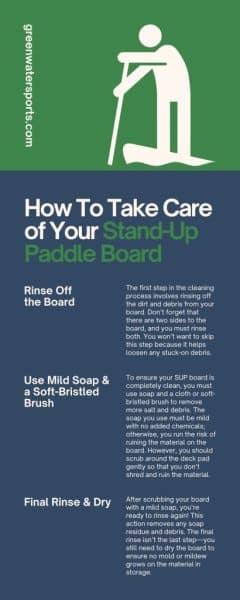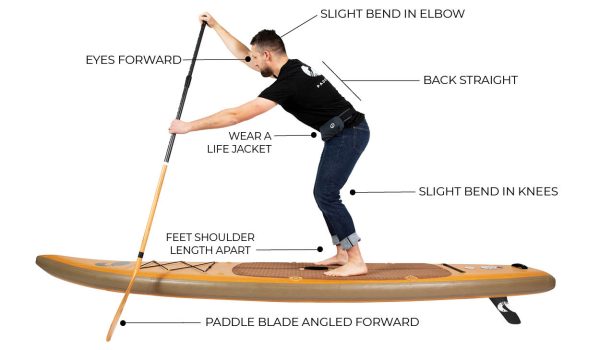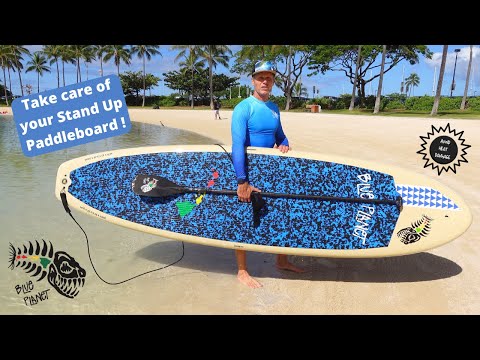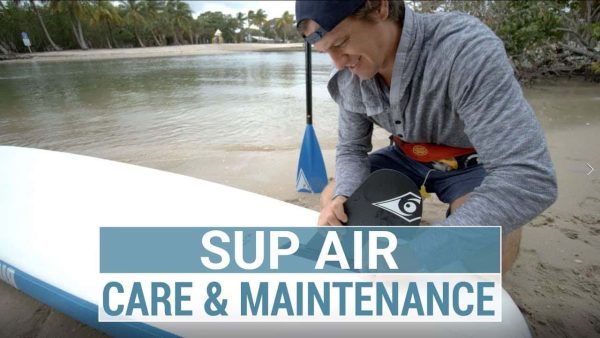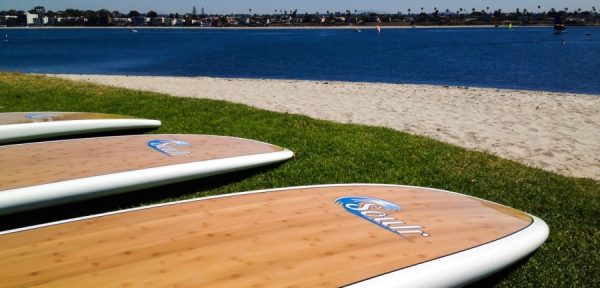If you’ve recently acquired a SUP board, congratulations! Now that you’re all set to embark on your water adventures, knowing how to properly care for and maintain your board is essential.
From proper storage techniques to regular cleaning and inspections, we’ll guide you through the essential steps to ensure your SUP board stays in top shape for years.
So, grab your sunscreen, and let’s dive into SUP board maintenance!
Cleaning and Storage
Rinsing after each use
One of the essential steps in caring for your SUP board is to rinse it thoroughly after each use. This is especially important if you have been paddling in saltwater, as the salt can corrode the materials over time. Use fresh water, a hose, or a bucket to rinse any salt, sand, or debris from the board’s surface.
Removing dirt and debris
In addition to rinsing, it’s crucial to remove any dirt or debris that may have accumulated on your SUP board. You can gently scrub the surface with a soft brush or sponge, paying particular attention to deck traction pads and other textured areas where dirt can get trapped. Be careful not to use abrasive cleaning materials that could scratch or damage the board.
Proper drying
After rinsing and cleaning, it’s essential to dry your SUP board thoroughly before storing it. Leaving your board wet or damp can promote the growth of mold and mildew, which can result in unpleasant odors and potentially compromise the board’s integrity. Wipe your board with a clean towel or let it air dry in a shaded, well-ventilated area.
Storing in a cool, dry place
When it comes to storing your SUP board, finding the right place is crucial for maintaining its condition. Store your board in a cool, dry area away from direct sunlight and extreme temperatures. Excessive heat or cold can cause the materials to weaken or warp over time. If possible, store your board horizontally or on its side, using a board rack or stand to prevent any unnecessary pressure or stress on the board.
Transportation and Handling
Using a suitable transportation method
When transporting your SUP board, selecting a suitable method that ensures its safety and prevents any damage is essential. Depending on the distance you need to cover and your mode of transportation, you can choose from options such as roof racks, board bags, or SUP travel cases. Make sure your chosen method provides secure and stable transport for your board.
Properly securing the board
Once you’ve chosen your preferred transportation method, it’s crucial to properly secure your SUP board to prevent it from shifting or falling during transit. Use solid and reliable straps or tie-downs to secure the board firmly. Avoid overtightening the straps, as this can cause unnecessary pressure on the board, potentially damaging it. Regularly check the straps during your journey to ensure they remain secure.
Avoiding excessive pressure or force
Whether during transportation or handling, it’s crucial to be mindful of avoiding excessive pressure or force on your SUP board. Avoid stepping or standing on the board unless it’s specifically designed to support your weight. Additionally, be careful not to drop heavy items or apply excessive force onto the board, leading to dents, cracks, or other damages.
Protecting from extreme temperatures
Extreme temperatures can have detrimental effects on your SUP board, so it’s crucial to protect it from both extreme heat and extreme cold. When parking your car or storing your board, avoid leaving it exposed to direct sunlight for extended periods, as the heat can cause the materials to weaken or warp. Similarly, avoid leaving your board in freezing temperatures, as this can cause the materials to become brittle and more susceptible to damage.
This image is the property of greenwatersports.com.
Repair and Maintenance
Regular inspection
Regularly inspecting your SUP board is an essential part of its maintenance. After each use, take the time to visually inspect the board for any visible damages or signs of wear. Check for cracks, dings, or any loose or damaged parts. By identifying and addressing these issues early on, you can prevent further damage and ensure the longevity of your board.
Repairing minor damages
If you encounter any minor damages during your inspection, such as small cracks or dings, it’s essential to address them promptly. Depending on the severity of the damage, there are various repair kits and techniques available. For minor cracks or dings, you can use epoxy resin or a suitable repair putty to patch up the damaged area. Follow the instructions provided with the repair kit and allow sufficient time for the repair to cure correctly.
Replacing broken or damaged parts
Sometimes, the damage to your SUP board may be beyond repair or too extensive to fix. When this happens, it’s crucial to replace the broken or damaged parts to ensure the board’s integrity and functionality. Contact the manufacturer or a professional SUP repair service to obtain the necessary replacement parts and seek guidance on the correct installation process.
Maintaining the board’s integrity
While minor repairs and part replacements are essential, it’s equally important to maintain the overall integrity of your SUP board. Avoid putting excessive stress or pressure on the board, as this can weaken the materials and potentially lead to more significant damages. Be mindful of the weight limits specified by the manufacturer and use your board within those limits to ensure its longevity.
Fins and Fin Boxes
Checking and cleaning the fin regularly
Your SUP board’s fin is crucial in providing stability and maneuverability. To ensure its optimal performance, checking and cleaning the fin regularly is essential. Inspect the fin for any signs of damage, such as cracks or loose screws, and tighten any loose screws if necessary. Use a soft brush or cloth to remove any dirt or debris that may have accumulated on the fin’s surface.
Proper installation and alignment
If you need to remove or replace the fin, installing and aligning it with the fin box properly is essential. Follow the manufacturer’s instructions or seek professional guidance if needed to ensure the fin is securely attached and aligned correctly. Proper alignment is vital for maintaining the board’s stability and optimizing its performance on the water.
Replacing damaged fins or fin boxes
If your fin becomes damaged beyond repair or your fin box sustains significant damages, it’s essential to replace it promptly. Contact the manufacturer or a reputable SUP repair service to obtain the correct replacement parts and seek assistance in replacing them. Using a damaged fin or fin box can compromise the board’s performance and potentially cause accidents or injuries.
Using fin protectors during transportation
To prevent any damage or accidents during transportation, consider using fin protectors. Fin protectors are specifically designed covers that provide an extra layer of protection for your fin. They help prevent any accidental impacts or collisions that could damage the fin or fin box. Ensure the fin protector fits securely and snugly over the fin to provide optimal protection.
This image is the property of paddlenorth.com.
Deck and Hull Protection
Using a board bag or protective cover
Using a board bag or protective cover is highly recommended when storing or transporting your SUP board. A board bag or cover provides an additional layer of protection against scratches, scuffs, and other potential damages. Look for a bag or cover designed for your board’s dimensions to ensure a proper fit and maximum protection.
Avoiding contact with sharp objects
To keep your SUP board in pristine condition, avoiding contact with sharp objects that can scratch or puncture the deck or hull is essential. Be mindful of your surroundings and avoid placing or dragging your board on rough surfaces, rocks, or other sharp objects. When carrying your board, use proper lifting techniques to minimize the risk of accidentally hitting it against anything sharp.
Applying wax or traction pads
To enhance your grip while paddling and to protect your SUP board’s deck, consider applying wax or traction pads. Wax provides an additional layer of grip, making it easier to maintain balance while standing on the board. Traction pads, which are adhesive pads with a textured surface, offer excellent grip without the need for wax. Apply wax or traction pads according to the manufacturer’s instructions or seek professional guidance.
Repairing any cracks or dings
If you notice any cracks or dings on your SUP board’s deck or hull, it’s essential to address them promptly. Use an appropriate repair kit, such as epoxy resin or a repair putty, to fill in any cracks or depressions. Follow the instructions provided with the repair kit and allow sufficient time for the repair to cure correctly. Repairing cracks and dings promptly can prevent further damage and maintain the integrity of your board.
Keeping the Board in Shape
Avoiding excessive exposure to sunlight
Excessive exposure to sunlight can harm your SUP board, leading to discoloration, fading, and material weakening. Store your board in a shaded area away from direct sunlight when not in use. If you’re spending an extended period on the water, consider using a board cover or a tarp to provide additional shade and protection.
Preventing warping or bending
To prevent warping or bending of your SUP board, avoid leaving it in hot or humid environments for extended periods. Extreme heat or moisture exposure can cause the materials to expand or contract, potentially leading to warping or bending. Additionally, avoid placing heavy objects on your board, as this can apply unnecessary pressure and lead to deformation.
Maintaining proper air pressure
Most inflatable SUP boards require inflation to a specific air pressure level for optimal performance. Maintaining the proper air pressure as specified by the manufacturer is essential. Regularly check the air pressure using a suitable pressure gauge and adjust it if necessary. Overinflation or underinflation can affect the board’s stability, buoyancy, and overall performance.
Avoiding overinflation or underinflation
To avoid damaging your inflatable SUP board, avoiding overinflation or underinflation is essential. Overinflating your board can cause excessive pressure on the seams and valves, potentially leading to leaks or bursts. Underinflation, on the other hand, can result in reduced stability and performance. Follow the manufacturer’s guidelines and use a reliable pump with a pressure gauge to ensure you achieve the correct air pressure.
This image is the property of i.ytimg.com.
Paddle Maintenance
Rinsing the paddle after each use
Just like your SUP board, it’s important to rinse your paddle thoroughly after each use. Rinse off any saltwater, sand, or debris that may have accumulated on the paddle’s shaft and blade. Use fresh water and a hose or a bucket to ensure a thorough rinse. This helps prevent salt corrosion and keeps your paddle in good condition.
Checking and tightening the paddle handle
Regularly check the paddle handle for any signs of looseness or wear. If you notice any looseness, tighten the handle using the appropriate tightening mechanism provided. Ensuring the handle is secure and in good condition is crucial for maintaining a comfortable and efficient grip while paddling.
Inspecting and replacing worn-out parts
Inspect your paddle regularly for any worn-out or damaged parts. Check the shaft, blade, and any connecting mechanisms for signs of wear, cracks, or other damages. If you notice any significant damage or wear, it may be necessary to replace the affected parts. Contact the manufacturer or a reputable paddle repair service for guidance and replacement parts.
Storing the paddle properly
Proper paddle storage is essential for maintaining its condition and prolonging its lifespan. Store your paddle in a cool, dry place away from direct sunlight and extreme temperatures. Avoid placing heavy objects on the paddle, as this can cause damage. If your paddle consists of multiple pieces, ensure they are securely connected or stored together to prevent misplacement or damage.
Safety and Precautions
Using a leash and wearing a life jacket
Safety, including stand-up paddleboarding, should always be a top priority when engaging in water activity. Using a leash is essential to ensure you remain connected to your board at all times in case of accidental falls or unexpected currents. Additionally, wearing a properly fitted life jacket or personal flotation device (PFD) is crucial, especially in more challenging water conditions.
Avoiding collisions or impacts with hard objects
When paddleboarding, you must be mindful of your surroundings and avoid collisions or impacts with complex objects, such as rocks, piers, or other watercraft. These collisions can not only cause damage to your SUP board but also pose a risk to your personal safety. Always maintain awareness of your surroundings and paddle with caution, especially in crowded or high-traffic areas.
Regularly checking the board’s stability
Stability is essential for a safe and enjoyable paddleboarding experience. Regularly check your SUP board’s stability to ensure it remains in good condition. If you notice any significant instability or unusual handling, inspect the board for any damages or defects that may be affecting its stability. Address any issues promptly to maintain a safe and confident paddling experience.
Being aware of weather conditions
Before heading out on your SUP board, it’s crucial to be aware of current and forecasted weather conditions. Check the wind speed, wave height, and any potential weather warnings. Avoid paddling in conditions beyond your skill level or pose unnecessary risks. Be prepared to adjust your plans or seek shelter if weather conditions deteriorate unexpectedly.
This image is the property of i.ytimg.com.
Cleaning Products and Tips
Choosing the right cleaning products
When cleaning your SUP board, choosing the right cleaning products is essential to avoid damaging the materials. Opt for mild soap or a specialized SUP board cleaner specifically formulated for the materials used in SUP boards. Avoid using abrasive or harsh chemicals that can strip away protective coatings or cause discoloration.
Using mild soap and water
For routine cleaning, a mixture of mild soap and water is usually sufficient. Fill a bucket with lukewarm water and add a small amount of mild soap. Use a soft brush or sponge to gently scrub the board’s surface, paying attention to any areas with dirt or stains. Rinse the board thoroughly with fresh water to remove any soap residue.
Avoiding abrasive or harsh chemicals
To protect your SUP board’s finish and materials, it’s important to avoid using abrasive or harsh chemicals during the cleaning process. These chemicals can damage the board’s surface, strip away protective coatings, or cause discoloration. Stick to mild soap, water, and specialized SUP board cleaners for gentle yet effective cleaning.
Properly rinsing and drying after cleaning
After cleaning your SUP board with soap and water or a specialized cleaner, it’s crucial to rinse off any residue thoroughly. Use a hose or bucket of fresh water to rinse the board, ensuring that all cleaning products are completely removed. After rinsing, dry the board thoroughly with a clean towel or let it air dry in a shaded, well-ventilated area before storing.
Professional Maintenance
Seeking professional help when necessary
Although regular maintenance can help keep your SUP board in good condition, professional help may be necessary. If you encounter significant damages or issues you are uncomfortable addressing on your own, it’s advisable to seek professional assistance. Contact the manufacturer or a reputable SUP repair service to assess and repair any significant damages.
Professional inspections and repairs
Professional inspections and repairs are essential to maintaining your SUP board’s performance and longevity. Consider scheduling periodic inspections with a professional to assess your board’s condition and address any hidden or potential issues. Professional repairs can ensure that any damages are appropriately fixed and that your board performs optimally.
Scheduled maintenance services
Many manufacturers or SUP shops offer scheduled maintenance services for SUP boards. These services include checking and tightening bolts, inspecting for hidden damages, and performing necessary repairs. Taking advantage of these scheduled maintenance services can help prolong the lifespan of your SUP board and ensure it remains in good working condition.
Following the manufacturer’s guidelines
Lastly, always refer to the manufacturer’s guidelines and recommendations for the proper care and maintenance of your SUP board. Every board may have different requirements based on materials, construction, and design. Following the manufacturer’s guidelines ensures that you are taking the correct steps to care for your board and avoid any potential issues.
In conclusion, proper care and maintenance are crucial for ensuring the longevity and performance of your SUP board. By following these comprehensive guidelines, you can keep your board clean, protect it from damage, and address any issues promptly. Remember to regularly inspect your board, clean it after each use, and store it in a cool, dry place.
Additionally, prioritize safety by using appropriate accessories, being aware of your surroundings, and following weather conditions. With proper care and maintenance, your SUP board will continue to provide you with countless enjoyable paddling experiences for years to come.
This image is the property of www.soulrsurfboards.com.


